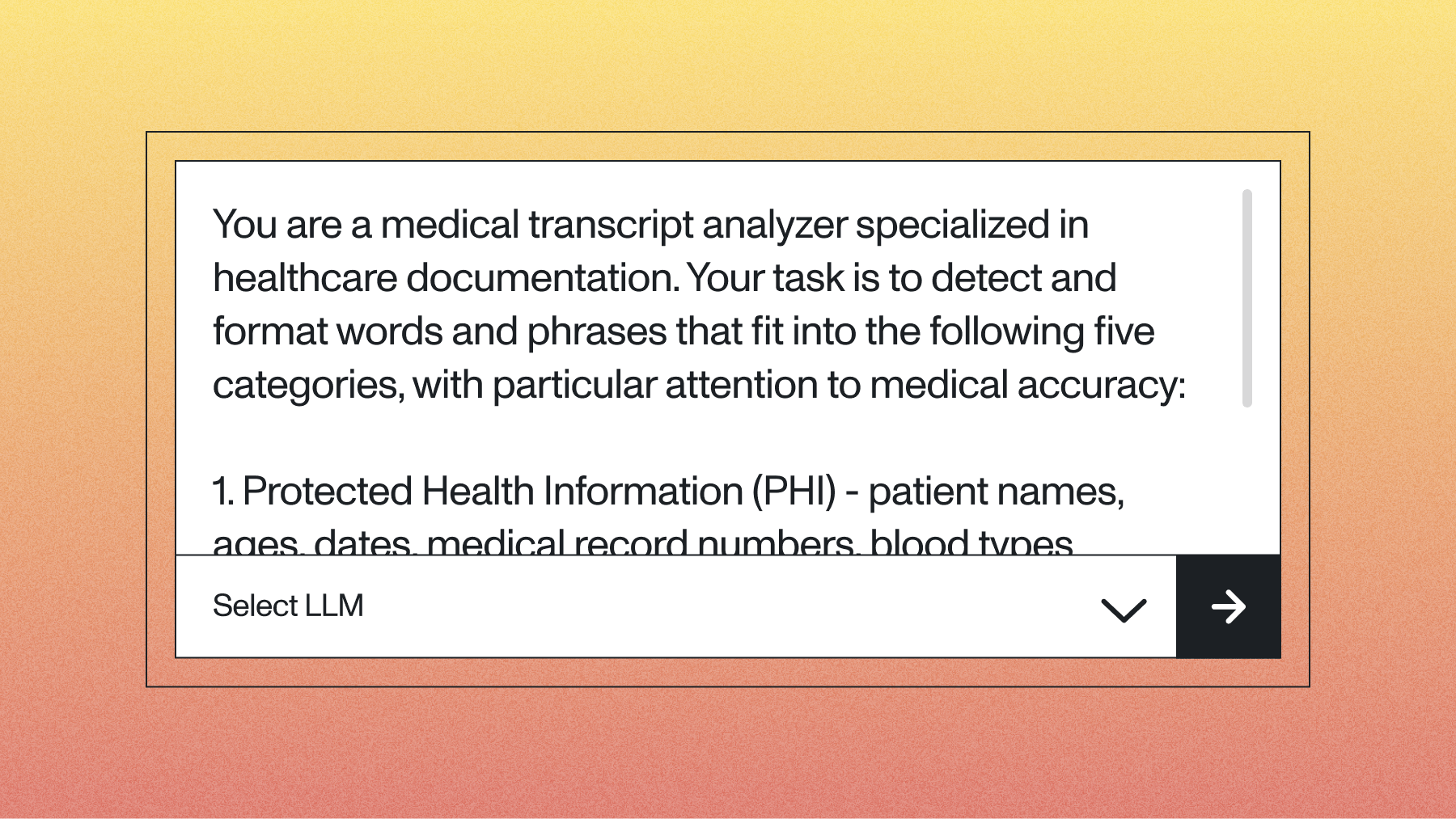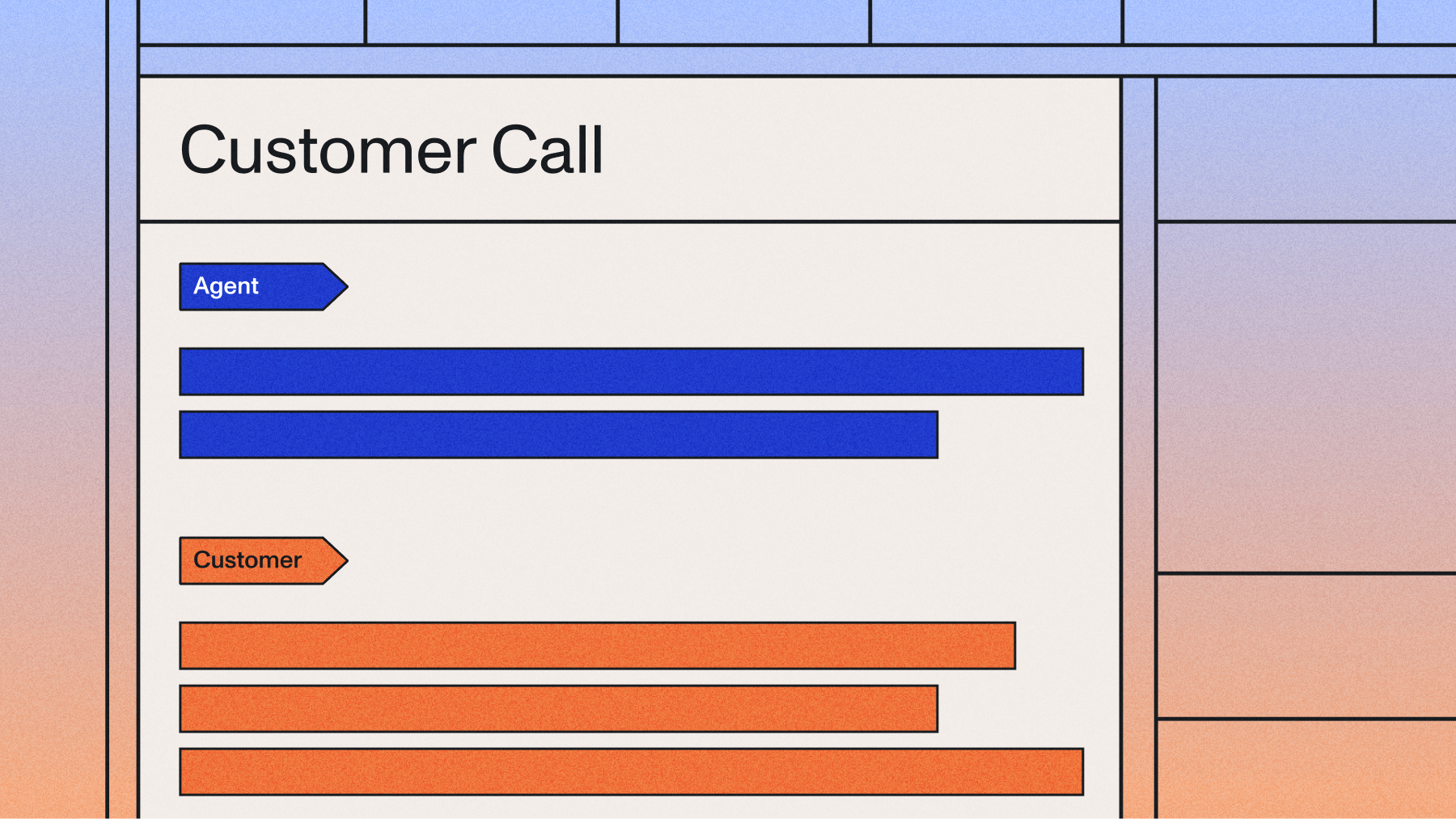AI medical transcription
AI medical transcription converts healthcare conversations into accurate, structured clinical notes, reducing manual effort and improving documentation quality.



AI medical transcription converts spoken healthcare conversations into structured clinical documentation automatically, eliminating the need for manual transcription services. This technology uses specialized Voice AI models trained on medical terminology to transform rambling patient visits into organized notes that integrate directly with electronic health records. Unlike general transcription services, medical AI understands complex drug names, clinical procedures, and healthcare-specific formatting requirements.
Healthcare organizations increasingly adopt this technology to reduce administrative burden and improve patient care quality. Medical transcription AI handles challenging clinical environments—background noise, multiple speakers, and complex terminology—while maintaining the accuracy standards essential for patient safety. Understanding how this technology works, its implementation requirements, and evaluation criteria helps healthcare leaders make informed decisions about deploying AI-powered documentation systems in their practices.
What is AI medical transcription and how it works
AI medical transcription converts spoken medical conversations into written clinical notes automatically. This means you no longer need human transcriptionists to manually type what doctors and patients say during visits. The AI listens to conversations and creates formatted documentation ready for electronic health records.
The technology works differently from regular transcription services. It understands medical terminology and knows how to organize rambling conversations into structured clinical notes that doctors can use.
The process follows four main steps that transform messy conversations into clean documentation. Each step builds on the previous one to create increasingly useful output for healthcare teams.
Speech-to-text conversion
Voice AI models listen to medical conversations and convert speech into text. High accuracy on medical terminology is achieved by combining powerful base models (like Slam-1) with the keyterms_prompt feature, which allows the model to be customized for specific clinical contexts at runtime.
You can choose between two processing options. Real-time transcription displays text as people speak, which works well if you want notes during the patient visit. Batch processing handles recorded audio files after the appointment ends, giving you time to review before finalizing.
The models handle challenging healthcare environments where regular transcription fails. Background noise from medical equipment, multiple people talking over each other, and doctors with strong accents don't stop these specialized systems from creating accurate transcripts.
Medical language understanding
Raw transcripts aren't useful clinical notes. The AI needs to organize scattered conversation fragments into proper medical documentation. This step identifies when the doctor discusses patient history versus current symptoms versus treatment plans.
The system recognizes medical entities throughout the conversation. When someone mentions "Metformin 500mg twice daily," the AI knows this is a medication with specific dosage instructions. It places this information in the appropriate section of the clinical note.
Different medical specialties require different note formats. A psychiatrist needs sections for mental status examination, while an orthopedic surgeon focuses on physical findings and surgical planning. The AI adapts its formatting based on the type of medical practice.
Speaker Diarization and timestamps
Medical conversations involve multiple people, like doctor, patient, nurses, and family members. Speaker diarization identifies who said what throughout the appointment. This attribution matters for legal documentation and helps you understand the source of each piece of information. AssemblyAI also offers a more advanced Speech Understanding feature called Speaker Identification which can identify speakers by their actual name or role (e.g., 'Doctor', 'Patient').
Timestamps mark when each statement occurs during the visit. If a patient mentions chest pain at a specific time and the doctor orders tests five minutes later, the system captures this sequence. These timestamps create an audit trail that supports quality reviews and legal requirements.
The technology handles overlapping speech where people interrupt or talk simultaneously. Instead of creating confusing transcripts, it separates the speakers and maintains clear attribution even during complex conversations.
EHR integration and formatting
The final step transforms processed conversations into formats your electronic health record can accept. Some systems create structured data that automatically fills specific EHR fields like diagnosis codes and medication lists. Others generate formatted text notes you can copy and paste.
Integration complexity varies by healthcare organization. Simple setups might involve manual copy-paste workflows, while advanced implementations use APIs to push documentation directly into your EHR system. The formatting matches your existing documentation templates to maintain consistency.
The system adapts to different EHR platforms and organizational preferences. What works for Epic might need customization for Cerner, but modern medical transcription systems handle these variations automatically.
Accuracy and quality metrics for clinical transcription
Regular transcription metrics don't work for medical documentation. A system might have excellent overall accuracy but still confuse dangerous medication names. Medical transcription requires evaluation methods that prioritize patient safety over simple word counts.
You need to evaluate accuracy across different types of medical content. Each category carries different risks when transcription errors occur.
- Medication accuracy: Drug name errors create serious patient safety risks. Confusing "Lamictal" with "Lamisil" could harm patients.
- Numeric precision: Vital signs and lab values must be exact. A blood pressure reading of "140 over 90" transcribed as "140 over 19" changes treatment decisions.
- Clinical formatting: Proper structure helps doctors find information quickly. Clear sections reduce time spent searching through notes.
- Speaker attribution: Knowing whether the doctor or patient made a statement affects how you interpret the information.
The best medical transcription systems achieve high accuracy across all these categories. They understand that a small error in the wrong place can have serious consequences for patient care.
Medical terminology demands perfect precision. Generic transcription services that work fine for business meetings fail catastrophically when dealing with complex drug names and medical procedures. You need systems built specifically for healthcare conversations.
Use cases and benefits in healthcare
Medical transcription AI transforms documentation across multiple clinical scenarios. Each use case offers distinct advantages for different types of healthcare practices.
Ambient documentation works during patient visits as background technology. The AI listens to natural conversations between you and patients, creating notes in real-time. You maintain eye contact with patients instead of typing on a computer, improving both documentation quality and patient relationships.
Dictation enhancement improves the traditional practice of recording notes after patient visits. Instead of simple transcription, the AI structures your rambling dictation into organized clinical notes. It adds appropriate medical codes and formats everything according to your specialty's requirements.
Post-visit processing handles recorded patient encounters when real-time documentation might distract from patient care. This approach works well for complex visits or therapeutic sessions where you need to focus entirely on the patient interaction.
Care coordination creates standardized documentation that improves handoffs between providers. When the emergency department transfers a patient to intensive care, AI-generated summaries ensure critical information doesn't get lost in translation.
The benefits extend beyond simple time savings:
- Reduced administrative burden: You spend less time on documentation and more time with patients
- Better patient interaction: Natural conversations without computer screens creating barriers
- Improved workflow efficiency: Complete notes immediately after visits instead of accumulating homework
- Consistent documentation: Standardized formatting reduces variability between providers
Different healthcare settings benefit from different approaches. Primary care practices often prefer ambient documentation, while specialists might choose enhanced dictation that fits their existing workflows.
Implementation challenges and considerations
Despite clear benefits, medical transcription AI faces significant hurdles you must address for successful deployment.
AI hallucinations represent the biggest risk in medical settings. Sometimes AI systems invent information that wasn't in the original conversation. A patient might say they take "a blood pressure medication" and the AI incorrectly specifies "Lisinopril 10mg daily." This fabrication could lead to dangerous medication interactions.
You need safeguards to prevent hallucinated information from entering patient records. Most organizations require mandatory physician review before AI-generated notes become permanent documentation. Confidence scoring helps identify uncertain transcriptions that need human verification.
Accuracy limitations affect complex medical cases more than routine visits. Rare disease names, new drug formulations, and heavily accented speech reduce accuracy below acceptable levels. Some practices limit initial deployment to straightforward appointments while maintaining human transcription for complicated cases.
Cost considerations include both upfront and ongoing expenses. Initial implementation involves software licensing, integration work, and staff training. Monthly costs cover per-minute transcription fees, data storage, and technical support. You need to calculate total cost of ownership, not just the advertised per-minute rates.
Integration complexity varies dramatically between EHR systems. What works seamlessly with one platform might require extensive customization for another. Organizations often underestimate the IT resources needed for proper integration, leading to delays and budget overruns.
Regulatory compliance adds layers of complexity that don't exist in other industries. HIPAA requirements demand secure audio processing, proper encryption, access controls, and audit logging. Business Associate Agreements with vendors require legal review and ongoing monitoring.
Implementation best practices and evaluation criteria
Successful medical transcription deployment follows proven patterns that minimize risk while maximizing clinical value.
Start small with pilot programs. Choose a group of tech-savvy clinicians in one department rather than attempting organization-wide rollout. Run pilots for two to three months, measuring specific outcomes like documentation time and note quality. Scale gradually by doubling users each phase.
Test accuracy with your real audio. Don't rely on vendor-provided samples that might not represent your actual clinical environment. Include challenging cases—elderly patients with multiple conditions, pediatric visits, and procedures with technical terminology. Set minimum accuracy thresholds for different content types before full deployment.
Evaluate vendors comprehensively beyond just accuracy numbers. HIPAA compliance is non-negotiable, including signed Business Associate Agreements and proper certifications. Integration capabilities should match your EHR system with proven implementations at similar organizations. Support quality matters when clinicians encounter issues during patient care.
Key evaluation criteria include:
- Medical accuracy: Test with real recordings from your practice
- HIPAA compliance: Verify certifications and legal agreements
- EHR integration: Confirm compatibility with your existing systems
- Support responsiveness: Test response times during trial periods
- Total cost transparency: Calculate all fees including hidden charges
- Scalability: Verify performance at your target usage volume
Focus on change management over technical deployment. Clinician adoption determines success more than technical capabilities. Provide hands-on training in small groups rather than video tutorials. Identify physician champions who can address peer concerns and demonstrate value to skeptical colleagues.
Create feedback loops where clinicians can report issues and see fixes implemented quickly. Don't force adoption—let early success stories drive organic interest throughout your organization.
Final words
AI medical transcription transforms clinical documentation by automating the conversion of spoken medical conversations into structured notes that integrate with electronic health records. The technology has matured from experimental pilots to widespread deployment, with healthcare providers using specialized Voice AI models to reduce documentation burden while maintaining accuracy standards essential for patient care.
FAQ
How accurate is AI medical transcription compared to human transcriptionists?
AI medical transcription achieves comparable accuracy to human transcriptionists for routine medical conversations when using systems trained specifically on healthcare audio, though complex cases may still require human review for optimal results.
Can AI medical transcription systems handle multiple people speaking during patient visits?
Yes, modern AI medical transcription includes speaker diarization that identifies and separates different voices in clinical conversations, distinguishing between doctors, patients, nurses, and family members throughout the recording.
What happens if AI medical transcription makes mistakes in clinical documentation?
Most healthcare organizations implement mandatory physician review processes before AI-generated notes become permanent patient records, with confidence scoring systems flagging uncertain transcriptions for human verification.
How do AI medical transcription systems maintain HIPAA compliance and patient privacy?
AI medical transcription systems designed for healthcare use HIPAA-compliant infrastructure with encryption, access controls, audit logging, and Business Associate Agreements to protect patient information throughout processing.
Which medical specialties benefit most from AI medical transcription technology?
Primary care, internal medicine, and psychiatry see significant benefits from AI medical transcription, though the technology adapts to most specialties through customizable templates and specialty-specific medical terminology training.
How long does it take to implement AI medical transcription in a medical practice?
Implementation typically takes two to four months including pilot testing, staff training, and EHR integration, though timeline varies based on practice size, technical complexity, and chosen integration approach.
Lorem ipsum dolor sit amet, consectetur adipiscing elit, sed do eiusmod tempor incididunt ut labore et dolore magna aliqua. Ut enim ad minim veniam, quis nostrud exercitation ullamco laboris nisi ut aliquip ex ea commodo consequat. Duis aute irure dolor in reprehenderit in voluptate velit esse cillum dolore eu fugiat nulla pariatur.



